Squashed My Coil
-
Recently Browsing
- No registered users viewing this page.
-
Topics
-
Posts
-
Recently inherited a box of my Grandfathers watches, nothing valuable, but some cool and some unique items. Seiko SQ, my aunt went to Hong Kong in the 80's I believe and picked one up for my Dad and Grandpa. Below are picture, I believe its a 1987 5Y22-8A08. Put a new battery in it and it fired right up! Its probably been a drawer for 20+ years. Looks like he only wore it a few times. Citizen Quartz 46-9181 with a seven jewel 7961B movement. It had what looked like some moisture damage, and a corroded battery. Swapped it with a 371 but it would only vibrate the second hand. Tried trouble shooting while in the case but eventually ended up pulling the movement out and cleaning with some naphtha and blowing it out and running it on the demagnetizer for a while to free up the movement before cleaning the band and case lightly oiling and reassembling everything. Now its back up and running. Based on the adjustment of the band I believe my Grandmother actually wore this watch, and I made the mistake of telling my wife that. Now its her watch! The most interesting so far is a 72-73 Benrus. I tried putting a battery in it, but no joy. Ran it on my little tester, no signal from the coil, tried to spin it up. Just the slightest flicker of the second hand. Put some naphtha where I could reach, and tried again to spin it up. Nope. This watch is interesting in that it does not look like the back comes off, there is a window you unscrew to access the battery, a huge SR44. Ordered a crystal puller and will begin disassembly next week. I was able to find a little bit about this watch though a google image search; BENRUS H010 TECHNIQUARTZ 1972 1st US made Quartz made by Benrus. Using a custom E-block with the step Motor, a power switch and a Moto Chip driven by MotoQ at 32KHz, on modified ETA mechanical movement. https://www.crazywatches.pl/benrus-h010-techniquartz-1972
-
It’s done and the movement feats/aligns perfectly in the case. I stripped off 10mm wide sandpaper and wrapped /sticked it around the pad with double sided tape. I run with 400 grit and finished with 1000 grit. Now I can continue with my build, I’m going to buy a dial and hands. The dial I am considering is a larger diameter 36.5mm than the allotted space 35mm in the case, so I will apply the same ‘technique’ with sandpaper and Dremel/drill. Thank you @RichardHarris123, @AndyGSi and watchrepairtalk community for your help.
-
As you're in the UK I suggest you look at Cousins for screwdriver sets as they've never cause me any problems. The key is the right blade, dressed correctly to suit the screw. https://www.cousinsuk.com/product/cousins-swiss-style-sets-rotating-stands https://www.cousinsuk.com/product/value-screwdriver-sets-wooden-cases https://www.cousinsuk.com/product/cousins-swiss-style-flat-stainless-steel
-
It's difficult to tell because of the dial ring but I expect it's the highest hand version they do know as a 'H6' The only way to be sure is to remove the hands and dial and measure the cannon pinion.
-
You're 100 % correct! I'm only interested in dissecting a counterfeit movement, and after that, destroying it. As a general rule, I would never buy, wear, or sell a counterfeit watch or movement. In this case, I'm willing to make an exception, as I want to get a feel for what a really good counterfeit feels like so I can better identify counterfeits. Thanks, that will be helpful! I absolutely see where you're coming from, and I'm basically in the same camp. However, I'm willing to make an exception if the purpose is to gain knowledge which will help to better combat counterfeits, and the movement isn't used for any other purpose than dissecting it and finally destroying it. Looking at the link provided by @GuyMontag most of the time we won't have any problem identifying a counterfeit. As experienced repairers of genuine Rolex movements, I would guess we would be able to identify a counterfeit in seconds. However, a well-made super clone of the movement might be harder to detect, and that's why I'm investigating the possibility of getting one. Thank you for your input and for helping clarify the situation — much appreciated. We’re right on topic. I’m currently servicing my second Rolex 3135 movement for a client, and I started this thread to document and discuss any issues or anomalies that may arise during the work. During disassembly, I encountered a few screws that, to me, appeared inconsistent with what I would think are typical Rolex finishing standards. This initially raised concerns that I might be dealing with a high-grade counterfeit or "super clone." Fortunately, those concerns were laid to rest, but the experience highlighted the importance of being able to reliably identify counterfeit components.
-






Recommended Posts
Join the conversation
You can post now and register later. If you have an account, sign in now to post with your account.
Note: Your post will require moderator approval before it will be visible.